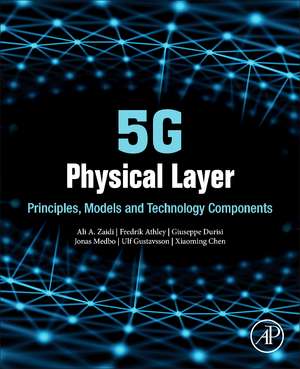5G Physical Layer: Principles, Models and Technology Components
Autor Ali Zaidi, Fredrik Athley, Jonas Medbo, Ulf Gustavsson, Giuseppe Durisi, Xiaoming Chenen Limba Engleză Paperback – 28 sep 2018
5G Physical Layer is very suitable for wireless system designers and researchers: basic understanding of communication theory and signal processing is assumed, but familiarity with 4G and 5G standards is not required.
With this book the reader will learn:
- The fundamentals of the 5G NR physical layer (waveform, modulation, numerology, channel codes, and multi-antenna schemes).
- Why certain PHY technologies have been adopted for the 5G NR.
- The fundamental physical limitations imposed by radio wave propagation and hardware impairments.
- How the fundamental 5G NR physical layer functionalities (e.g., parameters/methods/schemes) should be realized.
- A global view of 5G development – concept, standardization, spectrum allocation, use cases and requirements, trials, and future commercial deployments.
- The fundamentals behind the 5G NR physical layer specification in 3GPP.
- Radio wave propagation and channel modeling for 5G and beyond.
- Modeling of hardware impairments for future base stations and devices.
- Flexible multi-carrier waveforms, multi-antenna solutions, and channel coding schemes for 5G and beyond.
- A simulator including hardware impairments, radio propagation, and various waveforms.
With this book the reader will learn:
- The fundamentals of the 5G NR physical layer (waveform, modulation, numerology, channel codes, and multi-antenna schemes)
- Why certain PHY technologies have been adopted for the 5G NR
- The fundamental physical limitations imposed by radio wave propagation and hardware impairments
- How the fundamental 5G NR physical layer functionalities (e.g., parameters/methods/schemes) should be realized
- A global view of 5G development – concept, standardization, spectrum allocation, use cases and requirements, trials, and future commercial deployments
- The fundamentals behind the 5G NR physical layer specification in 3GPP
- Radio wave propagation and channel modeling for 5G and beyond
- Modeling of hardware impairments for future base stations and devices
- Flexible multi-carrier waveforms, multi-antenna solutions, and channel coding schemes for 5G and beyond
- A simulator including hardware impairments, radio propagation, and various waveforms
Preț: 424.49 lei
Preț vechi: 788.17 lei
-46% Nou
Puncte Express: 637
Preț estimativ în valută:
81.23€ • 86.86$ • 67.72£
81.23€ • 86.86$ • 67.72£
Carte tipărită la comandă
Livrare economică 10-24 aprilie
Preluare comenzi: 021 569.72.76
Specificații
ISBN-13: 9780128145784
ISBN-10: 0128145781
Pagini: 322
Dimensiuni: 191 x 235 mm
Greutate: 0.56 kg
Editura: ELSEVIER SCIENCE
ISBN-10: 0128145781
Pagini: 322
Dimensiuni: 191 x 235 mm
Greutate: 0.56 kg
Editura: ELSEVIER SCIENCE
Cuprins
1. 5G Radio Access
2. NR Physical Layer: Overview
3. Propagation & Channel Modeling
4. Hardware Impairment Modeling
5. Multicarrier Waveforms
6. NR Waveform
7. Multi-antenna Techniques
8. Channel Coding
9. Simulator
2. NR Physical Layer: Overview
3. Propagation & Channel Modeling
4. Hardware Impairment Modeling
5. Multicarrier Waveforms
6. NR Waveform
7. Multi-antenna Techniques
8. Channel Coding
9. Simulator
